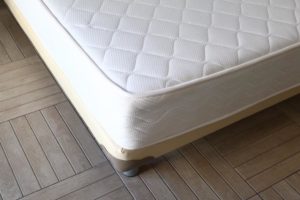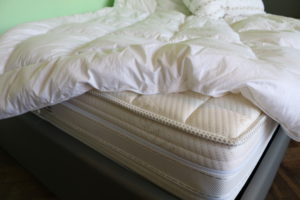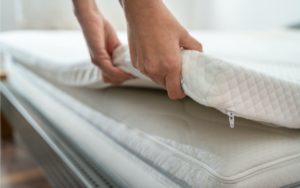What is the Difference Between Memory Foam and Latex?
Modern mattresses can be manufactured from a wide variety of materials. The choice of foams used in a mattress can substantially affect the bed’s feel, performance, and cost. Some of the most commonly used materials in quality mattresses are memory foam and latex foam. But what is the difference between memory foam and latex?
Let us help you find the perfect bed
Answer a few questions to find the right mattress for your unique needs
What is Memory Foam?
Memory foam is a type of polyurethane foam, a synthetic foam material. Its technical term is “viscoelastic polyurethane foam,” although most manufacturers simply refer to it as “memory foam.”
The material was first developed by NASA researchers, back in the 1960s. Memory foam is made by taking polyurethane and treating it with certain chemicals to increase its viscosity and density.
Unlike normal polyfoam, memory foam reacts to body heat, becoming softer and more conforming. When you lay down on memory foam, the material reacts with your body heat, and slowly adapts to the shape of your body. The result is the “body-hugging,” close-conforming feel that memory foam is famous for. When you get up, the foam material cools and returns to its normal shape.
Memory foam is prized for its body-hugging feel. It’s a moderately priced material, so you will find it featured in a wide range of mattresses. The biggest downside to memory foam is that it tends to trap body heat, so those that sleep hot may wish to think twice about a memory foam mattress.
What is Latex?
Latex is a natural material derived from the sap of rubber trees. The sap is extracted and processed to form a dense foam material. Finished latex foam has a similar consistency to synthetic materials like polyfoam, with some key differences.
Latex generally feels bouncier and somewhat less conforming than memory foam. It has a springy, rubber-like consistency, and is usually fairly dense. It’s also quite durable, as latex foams have a longer expected lifespan than materials like polyfoam.
Owners of latex mattresses appreciate that latex is naturally derived, highly durable, responsive, and generally more temperature-neutral than memory foam. On the other hand, it’s a fairly expensive material. The best latex mattresses are often priced at $1,500 or more, while memory foam beds can be found for a significantly lower price.
Trouble sleeping?
Answer these 5 easy questions to discover your perfect mattress

Trouble sleeping?
Answer these 5 easy questions to discover your perfect mattress
What position do you sleep in?

Side

Back

Stomach
What is the Difference Between Memory Foam and Latex?
There are several distinct differences between these two foam materials in terms of performance. While these are the general trends in performance, not all latex or memory foam is created equally. The overall feel, firmness, support, and durability will be impacted somewhat by the density of the latex and the memory foam, as well as the quality of the material.
Feel
Memory foam has a deep, body-hugging feel. It slowly adapts to the shape of your body when you first lay down and slowly returns to its original form when you move.
A latex mattress will have a much more bouncy, responsive feel to it. It still adapts to the shape of your body, but you will find that contours to your shape less than memory foam.
Support
Both mattress styles can be considered very supportive. Both materials do a good job of supporting the body, keeping the spine aligned, and improving comfort for the sleeper.
In the long-run, latex typically outperforms memory foam when it comes to properly supporting the sleeper’s body. This is due to its superior durability and responsiveness. While memory foam will eventually start to sag, reducing support, latex generally retains its shape and remains highly supportive throughout the lifespan of the mattress.
Pressure Relief
A mattress that does a good job of providing pressure relief will help alleviate pain in certain problem areas, including the hips, neck, and shoulders.
Memory foam does an excellent job of this, as it adapts directly to the shape of the body, cupping and cushioning common problem areas. So long as the mattress is sufficiently supportive, different parts of the body can sink in just as much as they need to without pushing the spine out of alignment, often reducing pain and discomfort for the sleeper. Latex also performs well in this area by contouring to a moderate degree, but most find that memory foam provides the best pressure relief.
Sleeper Body Type
The body type and weight of each sleeper also influences the performance of each mattress type.
Generally speaking, memory foam performs well for sleepers who weigh less than 230 pounds, but it may not be best for those who are heavier. Memory foam’s tendency to allow the body to sink in is generally a good thing, though for heavier sleepers, the foam may have too much give, resulting in a less supportive feel. Latex tends to perform better for heavier sleepers.
Temperature Neutrality
Memory foam tends to absorb and trap body heat, while latex does a better job of remaining at a neutral temperature. That being said, some manufacturers add extra features or materials to their memory foam to aid in temperature regulation. Cooling gel, open-cell foam, and various other technologies are all utilized to reduce memory foam’s tendency to sleep warm.
Motion Isolation
Motion isolation is a measure of how well a mattress keeps movement on one side of the bed from disturbing the sleeper at the opposite side. In this category, memory foam and latex earn similar ratings. Memory foam has slightly better motion isolation due to its body-hugging feel, but both materials do a very good job of reducing motion transfer.
Price
Latex is significantly more expensive than memory foam. The average latex mattress is roughly twice the price of the average memory foam mattress. With that said, latex is notably more durable, so the long-term cost difference is less substantial.
Durability & Warranty
Latex is usually more durable than memory foam. On average, a latex mattress has an expected useful lifespan of around 7.5-8.5 years, compared to 6-7 years for a memory foam mattress. Likewise, latex mattress warranties often cover the bed for a longer time frame, compared to memory foam.

Still have questions? Ask our community!
Join our Sleep Care Community — a trusted hub of sleep health professionals, product specialists, and people just like you. Whether you need expert sleep advice for your insomnia or you’re searching for the perfect mattress, we’ve got you covered. Get personalized guidance from the experts who know sleep best.






























































